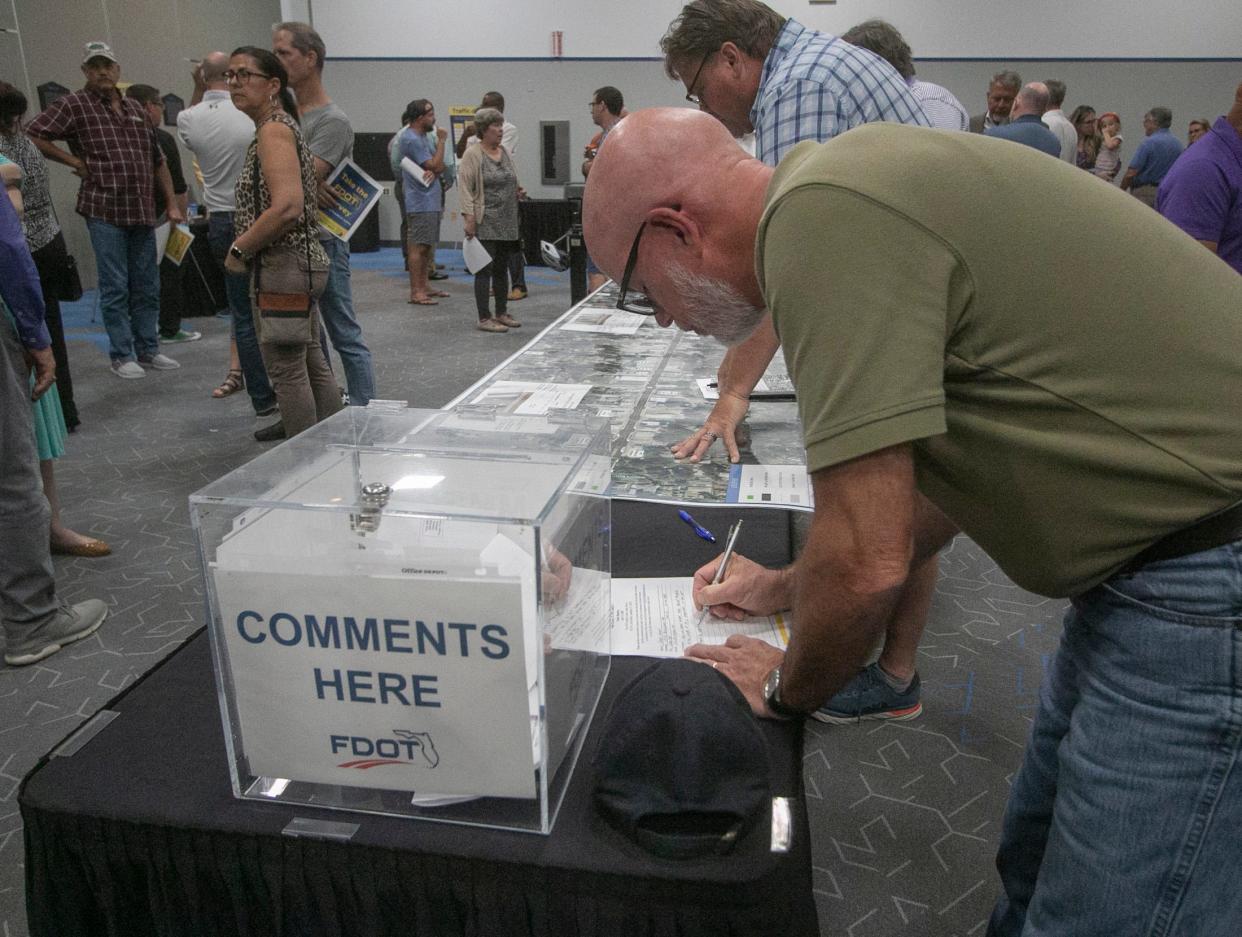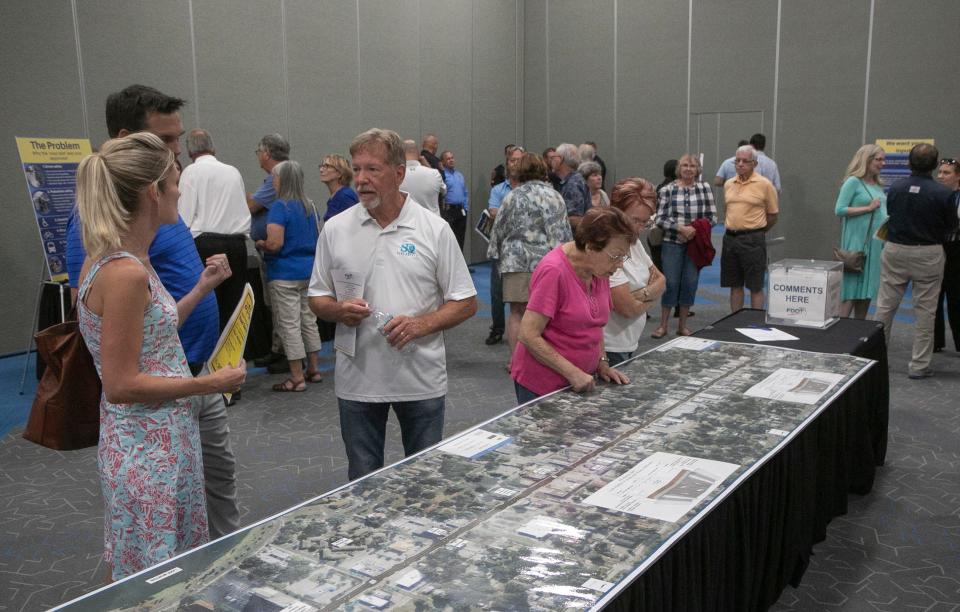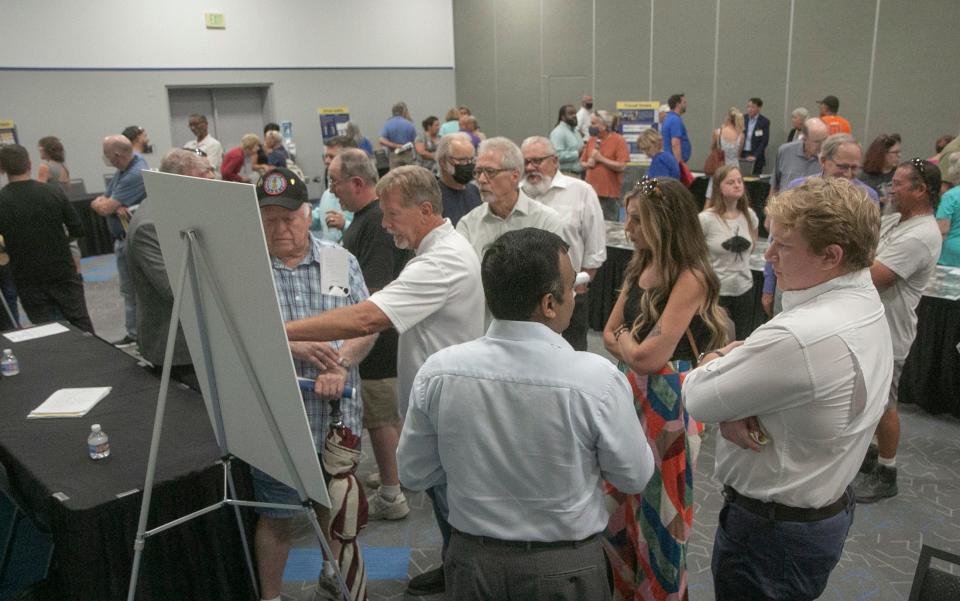South Florida Avenue 'road diet' reviews tied to user expectations

LAKELAND — A steady stream of roughly 108 people traveled into RP Funding Center's Sikes Hall on Monday nightto find themselves feeling uncertain how to navigate Florida Department of Transportation's public forum on the South Florida Avenue road diet and where to go next.
"We thought someone was going to explain things to us," Lakeland resident Jay Patel said. The event was set up similar to an information sessions where attendees could choose to approach displays and asks questions. FDOT offered no formal presentation as to its conclusion on the success of the road diet or what comes next.
"They released different road options," said Melody Stevens, a Lakeland resident. "I didn't see anywhere to vote or give any input."
Previously: Alternatives to South Florida Avenue 'Road Diet' offered. Will they work?
Public transit: Here's why public buses could be back on South Florida Avenue
There's strong correlation between how an individuals expect to utilize the roadway and what they perceive the changes will be.
It's a decision that Lakeland and the community need to make in order to move forward.
"I avoid the area now, I don’t even bother going down that way," Bobby Brigman, 56, a Lakeland resident for more than 20 years.
Brigman said he frequently drove along the one-mile stretch of South Florida Avenue from Lime Street south to Ariana Street, which has been narrowed from five lanes down to three without any problems.
"Just slow down," Brigman said. "When you come into a city area you slow down in traffic and as it opens up you can speed up again."
The narrow 9.5-foot width per lane under South Florida Avenue's prior configuration was non-conforming with state safety standards, according to FDOT. The road diet attempts to address this by creating three wider lanes — one travel lane in each direction and a center turning lane.
FDOT's preliminary findings found traffic to the overall 'road diet' area on South Florida Avenue and major intersections decreased by nearly 15%.
Feedback wanted: FDOT, city launch interactive survey of South Florida Avenue 'road diet'
The impact the drop in vehicular traffic has impacted local businesses on the road differently.
Praful Patel, co-owner of Baskin Robbins on South Florida Avenue, said that his patrons largely arrive at his business via car. The decrease in vehicular traffic has cut into his bottom line.
"People know the road is going to be busy, so they don't go there," he said. "It's nothing good for business."
Patel said he would like to see the road returned to at least four lanes across. He prefers Option 8 from consultant Ayres Associates' suggested alternatives: four lanes across with center divider or median. Under this suggestion, sidewalks would remain six feet in width.
Stevens, a Lakeland Regional Health employee, who regularly travels South Florida Avenue going to and from work said she also prefers to Option 8. She believes it would handle the volume of traffic easier.

FDOT officials said the road diet has had 'minimal' to no impact on average travel times during the morning rush hour. However, FDOT found the evening rush hour saw travel times increase by 14 seconds northbound and more than two minutes traveling south.
One reason for the difference between perceived travel time and actual may be issues with the sychronization of traffic lights along the corridor Stevens, Patel and others said. The timing of the four traffic lights over the four-mile stretch also appears off, sometimes resulting in long delays with no oncoming vehicles.
Wendy Johnson and AJ Jackson, who opened Krazy Kombucha roughly a year ago during the road diet, said they appreciate the positive changes.
'What's the other option?': Lakeland officials seek alternatives to South Florida Ave. road diet
"The difference from coming in there to now, we have seen traffic slow down and we're happy with that," Johnson said. "When people slow down, they see us. "
Johnson said she hopes drivers can come to appreciate a slower drive through the historic Dixieland district.
"I love it, love it," Dixieland resident Michael Schram who works with Low Country Vintage. "Prior to this whole thing, I would never recommend someone walk to Dixieland Relics when they ask what else is in the neighborhood."
Schram said the fast-moving traffic and narrow sidewalks caused him to fear for people's lives. He wouldn't recommend walking across roadway to Reesecliff Family Diner for a meal, but feels more comfortable doing so now. He'd like to see extended sidewalks along South Florida Avenue.

Johnson said she feels extending the sidewalks out to 12 feet as proposed in some of the alternatives, would help pedestrians feel safer and improve foot traffic to small businesses.
"Right now, the sidewalks are crumbling and they are really dangerous," she said.
Dixieland resident Roberto Leider, who has taken up regularly traveling to work and local errands using an electric scooter, said the poor condition of the sidewalks are problematic to encouraging pedestrian and bicyclist use. This was one of the key goals stated by FDOT and city officials in implementing the road diet.
Development: New 'micro hospital' could soon be heading to South Florida Avenue
Leider said he's encountered low-hanging trees over the sidewalk, broken concrete, intersecting driveways not level with the sidewalk and crossings that lack ramps for bicyclists.
Leider said he would like to see Option 1 proposed by Ayres, a two-lane road with a center turn lane or median and dedicated five-foot bike lane on the edges of the road.
"The street needs to be safe for cyclists if you want them to use it," he said. "There needs to be connectivity."
Dixieland resident Connie Haynes carried a poster board to the meeting with more than a dozen photos showing sidewalks in the road diet that fail to meet Americans with Disabilities Act compliance. Issues with street lamps, protective barrier poles placed have been installed in a way that wheelchair users would have difficulty getting through.
Tonya Rogers, president of Dixieland Neighborhood Association, said she's a fan of the road diet with one exception.
"I have no issues with it all," she said. "Except for the concrete curbs, I never thought those were permanent anyway."
Rogers said she's like to see Option 2 presented by Ayres Associates, which would keep the road diet's three lane configuration, or turn the center travel lane into a median, while extending the sidewalk to 12-feet across for shared pedestrian and bicyclist use.
"There's a lot of scooters and wheelchairs around Dixieland," she said.
Did you know: Florida's Children Museum to open new location in November
Rogers and her husband, Chris, said they've had community members ask if there could be dedicated left-hand turn signals at specific intersections to allow residents easier access to sideroads.
Lakeland officials promised the community's reaction to the road diet would be fully considered before deciding whether the reduction to three lanes would become permanent.
The online survey will remain open for feedback at metroquestsurvey.com/qn1i1c. A brief welcome section explains what the project did. A longer overview is available online at www.swflroads.com/sr37/arianatolime.
FDOT is anticipated to present its final conclusions and all comments received to Lakeland commissioners in August. The commission will be expected to make a recommended decision about the road and its final configuration this fall that will go back to the state.
Sara-Megan Walsh can be reached at swalsh@theledger.com or 863-802-7545.
This article originally appeared on The Ledger: S. Florida Ave. 'road diet' info session held at RP Funding Center

